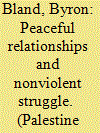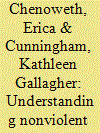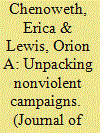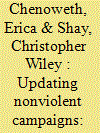|
|
|
Sort Order |
|
|
|
Items / Page
|
|
|
|
|
|
|
| Srl | Item |
| 1 |
ID:
129804


|
|
|
|
|
| Publication |
2014.
|
| Summary/Abstract |
The purpose of a peace process is to reach and implement an agreement that ushers forth peace. The belief is that negotiations will lead to a settlement that, if properly implemented, will create peace where previously only animosity and violence had existed. Acting under this paradigm international actors- the United States, the European Union, the United Nations, etc.
|
|
|
|
|
|
|
|
|
|
|
|
|
|
|
|
| 2 |
ID:
120765


|
|
|
|
|
| Publication |
2013.
|
| Summary/Abstract |
The events of the Arab Spring of 2011 have made clear the importance and potential efficacy of nonviolent resistance, as well as the field's inability to explain the onset and outcome of major nonviolent uprisings. Until recently, conflict scholars have largely ignored nonviolent resistance. This issue features new theoretical and empirical explorations of the causes and consequences of nonviolent resistance, stressing the role that unarmed, organized civilians can play in shaping the course of conflicts. Contributors demonstrate the importance of treating nonviolent and violent strategies, as well as conventional politics strategies, as alternative choices for engaging the state, show how gender ideology can influence which opposition groups use nonviolent resistance, and suggest that the causes of civil war and nonviolent resistance often differ. Other pieces highlight the role of public attitudes regarding whether nonviolent resistance and violence are employed, how experience with activism and repression by the state can shape activists' perceptions of justice, and how the perceptions of resistance leaders can influence strategic choices. Moreover, several articles examine the key role that security force defections can play in the success of nonviolent resistance, how micro-level nonviolent tactics can improve security in civil war, and how nonviolent campaigns can influence the stability of autocratic states. These contributions suggest that rigorous empirical study of civilian-based contentious politics (rather than only violent contention by armed non-state actors) must be incorporated into the conflict literature. Improved theory and data on the subject will help researchers and policymakers to shape strategies to support these movements when appropriate, and to manage changes in the international system that result from the success of nonviolent uprisings.
|
|
|
|
|
|
|
|
|
|
|
|
|
|
|
|
| 3 |
ID:
120775


|
|
|
|
|
| Publication |
2013.
|
| Summary/Abstract |
Recent studies indicate that strategic nonviolent campaigns have been more successful over time in achieving their political objectives than violent insurgencies. But additional research has been limited by a lack of time-series data on nonviolent and violent campaigns, as well as a lack of more nuanced and detailed data on the attributes of the campaigns. In this article, we introduce the Nonviolent and Violent Campaigns and Outcomes (NAVCO) 2.0 dataset, which compiles annual data on 250 nonviolent and violent mass movements for regime change, anti-occupation, and secession from 1945 to 2006. NAVCO 2.0 also includes features of each campaign, such as participation size and diversity, the behavior of regime elites, repression and its effects on the campaign, support (or lack thereof) from external actors, and progress toward the campaign outcomes. After describing the data generation process and the dataset itself, we demonstrate why studying nonviolent resistance may yield novel insights for conflict scholars by replicating an influential study of civil war onset. This preliminary study reveals strikingly divergent findings regarding the systematic drivers of nonviolent campaign onset. Nonviolent campaign onset may be driven by separate - and in some cases, opposing - processes relative to violent campaigns. This finding underscores the value-added of the dataset, as well as the importance of evaluating methods of conflict within a unified research design.
|
|
|
|
|
|
|
|
|
|
|
|
|
|
|
|
| 4 |
ID:
189002


|
|
|
|
|
| Summary/Abstract |
In this article, we introduce an updated version of the Nonviolent and Violent Campaigns and Outcomes dataset (NAVCO 2.1), which compiles annual data on 389 nonviolent and violent mass movements for regime change, anti-occupation, and secession from 1945 to 2013. This version of the dataset corrects known coding errors in NAVCO 2.0, adds news cases (including the Arab uprisings), and codes attributes for each campaign year (such as participation size and diversity, the behavior of regime elites, repression and its effects, support from external actors, and campaign outcomes). In addition, NAVCO 2.1 adds several new attributes to each campaign-year, including more precise participation figures, more nuanced data about the scope, intensity, and degree of violent flank behavior and state repression, and further information about the parallel or alternative institutions developed by the campaign. The data reveal four key findings: (1) that the success rate of nonviolent resistance campaigns has declined since 2001; (2) that far more people have participated in nonviolent than violent campaigns in the postwar period; (3) that nonviolent campaigns suffer far fewer per-capita fatalities than armed campaigns; and (4) that incidental violence by dissidents has become a more common feature of contemporary nonviolent campaigns compared with earlier cases. The article concludes with suggestions for further research.
|
|
|
|
|
|
|
|
|
|
|
|
|
|
|
|
|
|
|
|
|